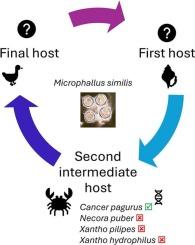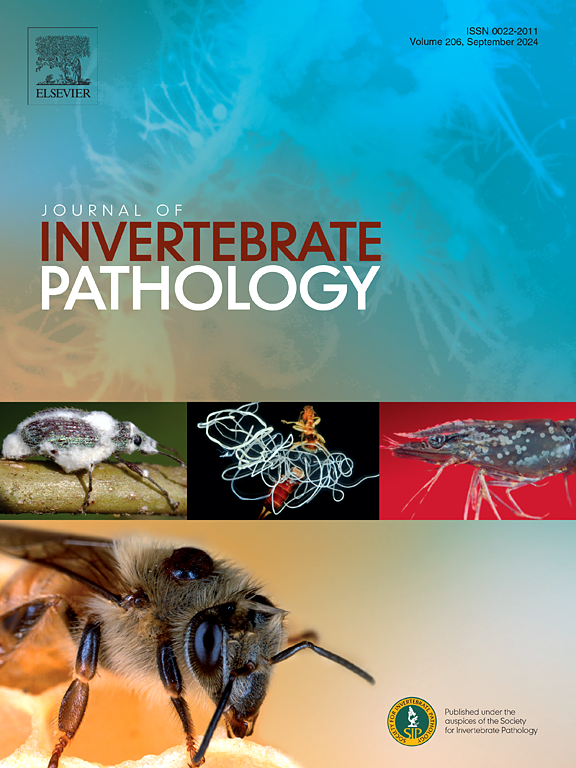Are all brachyuran crabs found in the intertidal zone intermediate hosts for digenean parasites?
IF 2.4
3区 生物学
Q1 ZOOLOGY
引用次数: 0
Abstract
Digenean trematodes with complex life cycles often use marine crabs as intermediate hosts, but their distribution across crab species is not fully understood. Previous reports of Microphallus similis in edible crabs (Cancer pagurus) relied on morphological identification, leaving potential for misidentification. This study aimed to investigate the prevalence, identity, and host range of digenean parasites in intertidal brachyuran crabs from South Wales, U.K. Over six months, crabs were collected from two rocky shore sites and examined for metacercariae in the hepatopancreas. Parasites were morphologically assessed and identified by sequencing the 28S rDNA region. Metacercariae were found exclusively in juvenile C. pagurus, with ∼ 30 % prevalence and low individual burdens ranging from 1 to 69 cysts. All sequenced parasites were confirmed as M. similis. No infections were detected in Necora puber, Xantho pilipes, or X. hydrophilus. Logistic regression indicated that infection prevalence in C. pagurus varied significantly with month and crab size. This study provides the first molecular confirmation of M. similis in edible crabs from the U.K. and highlights species-specific susceptibility linked to differences in ecology and feeding behaviour. The absence of infection in co-occurring crabs suggests that C. pagurus plays a uniquely important role in the parasite’s transmission cycle in intertidal environments.

潮间带发现的所有短爪蟹都是地沟寄生虫的中间宿主吗?
具有复杂生命周期的地沟吸虫常以海蟹为中间寄主,但其在蟹类中的分布尚不完全清楚。以往关于食用蟹(Cancer pagurus)中相似小阳虫(Microphallus similis)的报道依赖于形态学鉴定,存在误认的可能。本研究旨在调查英国南威尔士潮间带短爪蟹中地沟寄生虫的流行程度、身份和宿主范围。在六个月的时间里,我们从两个岩岸地点收集了蟹,并检查了肝胰脏中的囊蚴。通过28S rDNA区测序对寄生虫进行形态鉴定和鉴定。囊蚴只存在于幼年棘球绦虫中,患病率约30%,个体负担低,1 ~ 69个囊肿。所有测序结果均证实为相似支原体。未检出雏菊、黄原菌、嗜水x菌感染。Logistic回归分析表明,不同月龄和月龄的蟹感染率差异显著。这项研究首次在英国食用螃蟹中证实了相似分枝杆菌的存在,并强调了与生态和摄食行为差异相关的物种特异性易感性。在共发生的螃蟹中没有感染表明,C. pagurus在潮间带环境中寄生虫的传播周期中起着独特的重要作用。
本文章由计算机程序翻译,如有差异,请以英文原文为准。
求助全文
约1分钟内获得全文
求助全文
来源期刊
CiteScore
6.10
自引率
5.90%
发文量
94
审稿时长
1 months
期刊介绍:
The Journal of Invertebrate Pathology presents original research articles and notes on the induction and pathogenesis of diseases of invertebrates, including the suppression of diseases in beneficial species, and the use of diseases in controlling undesirable species. In addition, the journal publishes the results of physiological, morphological, genetic, immunological and ecological studies as related to the etiologic agents of diseases of invertebrates.
The Journal of Invertebrate Pathology is the adopted journal of the Society for Invertebrate Pathology, and is available to SIP members at a special reduced price.

 求助内容:
求助内容: 应助结果提醒方式:
应助结果提醒方式:


